-
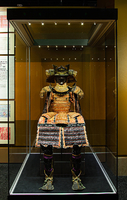 Antique Armor 14
Antique Armor 14 "Japanese Samurai armor, presented to President Theodore Roosevelt by the Emperor of Japan after the Portsmouth Peace Conference, ending the Russo-Japanese war, September 5, 1905. The color of this armor indicates a samurai of great authority. Heraldic (mons) on the armor belonged to several important families such as the Hosokawa, Ogasawara and Shibata. The helmet bowl dates from 1532-1555 and was made by Miochin Nobufusa, a pupil of the most famous armorer, Nobuiye. The face mask (mempo) was made by Miochin Munekatsu working about 1800-1854. The complete suit was probably mounted between 1850-1875."
-
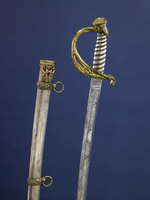 Twice Captured Presentation Sword
Twice Captured Presentation Sword This sword was first presented to C.W. Brandt by the 1st New York Veteran Cavalry. It was subsequently captured and presented to Lieutenant Colonel John S. Mosby by Lieutenant A.E. Richards on March 10th, 1864. The sword was recaptured and presented to Colonel H.S. Gansevoort by the 13th New York Cavalry in September 1864.
The blade of this Model 1850 Presentation Sword is long, curved, and single edged. It is decorated on both sides with floral and scroll designs in silver chasing. On the obverse is an eagle holding a banner that reads, "E PLURIBUS UNUM". On the reverse is a "U.S." monogram in place of the eagle. The grip is cylindrical and wrapped with gilt wire 11 times in a spiral. The pommel is shaped like a traditional Model 1850 sword, and scroll designs are featured its edges. The knuckle guard and counterguard are decorated with scroll designs. The quillon curls down to the blade in a scroll design.
The scabbard has three mounts. The first two are small and thin, and feature casts of oak sprays and acorns and the drag features a scroll design. There are four inscriptions on this scabbard, one on the obverse and three on the reverse. Two of the inscriptions (obverse and left reverse) bear the name of the sword's original owner “Presented by / Co.L. 1st N.Y. Vet. Cav. / as a mark of Esteem / to C.W. Bryandt.” The next, (center reverse), reads "Captured March 10th 1864 / and Presented / by Lt. A.E. Richards / to / Lt. Col. John Singleton Mosby", and the last inscription, (right reverse), reads "Recaptured / Sept 1864 / by the 13TH N.Y. Cavalry / Col. H.S. Gansevoort". There are two carrying rings on the scabbard, one on the right side of the top two mounts.
Maker of hilt - Hunt & Goodwin
Maker of blade - W. Clauberg
-
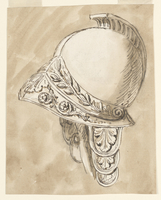 Helmet
Helmet A pen and ink drawing of a Greek and Roman Helmet. Giuseppe Barberi captured the metalwork of the piece of armor.
-
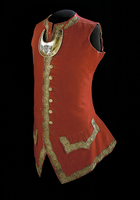 Adam Stephen’s Waistcoat and Gorget
Adam Stephen’s Waistcoat and Gorget Uniform waistcoat worn by Lieutenant Colonel Adam Stephen during the French and Indian War. Stephen was George Washington’s Second-in-Command of the Virginia Regiment.
The Virginia Regiment saw active service in Western Pennsylvania from 1754 to 1759. In 1755, the officers of the Virginia Regiment received orders from Washington to provide themselves with a "Suit of Regimentals" of good blue cloth. The coat was to be faced and cuffed in scarlet and trimmed with silver; they were to wear blue wool breeches and a scarlet wool waistcoat with silver lace. The waistcoat which extended to below the hips was typically worn over a plain shirt.
A gorget is part of the full dress uniform. It is a vestige of plate armor, symbolizing rank and authority.
-
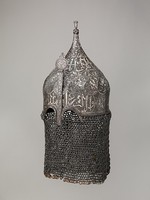 Helmet with Aventail
Helmet with Aventail This especially attractive and well preserved turban helmet retains the mail aventail that protected the lower half of the face and neck. The aventail is fixed with a lead seal stamped with the mark used in the Ottoman arsenals, an indication that this example, like the other turban helmets also in the Museum's collection (acc. nos. 04.3.209, .210, .214, .457, .462; 36.25.109), passed into Turkish possession as booty with the Ottoman conquest of Iran and the Caucasus.
At least one turban helmet decorated in a style comparable to this example bears the name of Farruhk-Siar (reigned 1464–1501), ruler of Shirvan in the Caucasus. Such evidence suggests that this helmet is also of Shirvan manufacture.
-
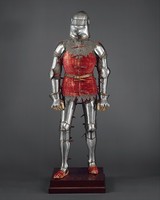 Armor
Armor This armor was assembled and restored under the direction of Dr. Bashford Dean in the 1920s, when it was part of his private collection. It consists of elements mostly from Chalcis, such as those exhibited in the vitrines to the left and right. Dean's intent was to present a full armor of the style worn about 1400, a period from which no complete armors survive. Distinctive features are the early form of brigandine (a torso defense constructed of plates riveted inside a doublet) and the brass borders on the edges of the exposed plates of the other parts of the armor. Portions of the brass at the top edge of the left cuisse (thigh defense), the lower edges of the right greave (lower leg defense), and the visor are genuine; the remainder of the brass is restored. The helmet, a visored bascinet, is not from Chalcis. The velvet covering of the brigandine is a restoration of the early twentieth century.
-
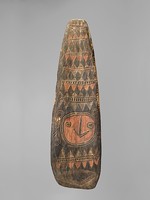 Shield (Tiye)
Shield (Tiye) A sheild made by and used by the Mukabuki village Papua New Guinea people, Upper Sepik, April River Papua New Guinea
-
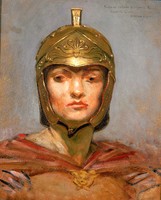 Statute Law - Helmet for Figure of "Force"
Statute Law - Helmet for Figure of "Force" A study done in preparation of a mural.
At the turn of the twentieth century, American artists decorated important public buildings with colorful and theatrical murals, images that were meant to enhance architectural spaces and impart lessons of good taste and moral values. In 1898 the National Society of Mural Painters nominated Kenyon Cox and nine other members to create murals for the new state appellate court building in New York City. The space given to Cox was the most challenging: Only four feet high and thirty-five feet long, it had two smaller, angled areas at each end. He chose to paint allegorical figures symbolizing the principles of law. This study for the figure of Force shows a woman wearing a helmet and looking out with a formidable expression; it is the kind of detailed sketch Cox made of each figure before beginning the mural. (Morgan, Kenyon Cox, 1856-1919: A Life in American Art, 1994)
-
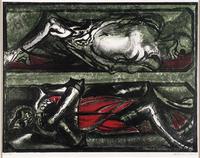 Man and Armor
Man and Armor Two medieval figures in a crypt. One skeleton and one corpse in armor are stacked one atop the other in their niches. Reminiscent of the Crusades and other Medieval imagery from the 15th century.
-
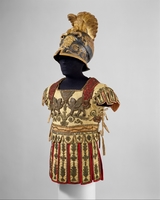 Costume Armor and Sword in the Classical Style
Costume Armor and Sword in the Classical Style This pseudoclassical armor was created to be worn at an event and not on the battlefield.
Pageants in pseudoclassical dress were popular in Europe from the sixteenth through the eighteenth century. An elaborate costume of the kind displayed here may have been worn for a theatrical performance or a court festivity, such as a ball or carousel in which the theme was taken from classical mythology or history.
The embroidered tunic represents an embossed bronze cuirass of the type worn by high-ranking Roman officers. The stylized Greek helmet is richly decorated with mythological and allegorical figures. Inside the helmet is the original paper label that identifies the Parisian maker as Halle dit Mercier and advertises his ability to provide helmets, shields, masks, costumes, and scenery for any occasion.
 Antique Armor 14 "Japanese Samurai armor, presented to President Theodore Roosevelt by the Emperor of Japan after the Portsmouth Peace Conference, ending the Russo-Japanese war, September 5, 1905. The color of this armor indicates a samurai of great authority. Heraldic (mons) on the armor belonged to several important families such as the Hosokawa, Ogasawara and Shibata. The helmet bowl dates from 1532-1555 and was made by Miochin Nobufusa, a pupil of the most famous armorer, Nobuiye. The face mask (mempo) was made by Miochin Munekatsu working about 1800-1854. The complete suit was probably mounted between 1850-1875."
Antique Armor 14 "Japanese Samurai armor, presented to President Theodore Roosevelt by the Emperor of Japan after the Portsmouth Peace Conference, ending the Russo-Japanese war, September 5, 1905. The color of this armor indicates a samurai of great authority. Heraldic (mons) on the armor belonged to several important families such as the Hosokawa, Ogasawara and Shibata. The helmet bowl dates from 1532-1555 and was made by Miochin Nobufusa, a pupil of the most famous armorer, Nobuiye. The face mask (mempo) was made by Miochin Munekatsu working about 1800-1854. The complete suit was probably mounted between 1850-1875." Twice Captured Presentation Sword This sword was first presented to C.W. Brandt by the 1st New York Veteran Cavalry. It was subsequently captured and presented to Lieutenant Colonel John S. Mosby by Lieutenant A.E. Richards on March 10th, 1864. The sword was recaptured and presented to Colonel H.S. Gansevoort by the 13th New York Cavalry in September 1864. The blade of this Model 1850 Presentation Sword is long, curved, and single edged. It is decorated on both sides with floral and scroll designs in silver chasing. On the obverse is an eagle holding a banner that reads, "E PLURIBUS UNUM". On the reverse is a "U.S." monogram in place of the eagle. The grip is cylindrical and wrapped with gilt wire 11 times in a spiral. The pommel is shaped like a traditional Model 1850 sword, and scroll designs are featured its edges. The knuckle guard and counterguard are decorated with scroll designs. The quillon curls down to the blade in a scroll design. The scabbard has three mounts. The first two are small and thin, and feature casts of oak sprays and acorns and the drag features a scroll design. There are four inscriptions on this scabbard, one on the obverse and three on the reverse. Two of the inscriptions (obverse and left reverse) bear the name of the sword's original owner “Presented by / Co.L. 1st N.Y. Vet. Cav. / as a mark of Esteem / to C.W. Bryandt.” The next, (center reverse), reads "Captured March 10th 1864 / and Presented / by Lt. A.E. Richards / to / Lt. Col. John Singleton Mosby", and the last inscription, (right reverse), reads "Recaptured / Sept 1864 / by the 13TH N.Y. Cavalry / Col. H.S. Gansevoort". There are two carrying rings on the scabbard, one on the right side of the top two mounts. Maker of hilt - Hunt & Goodwin Maker of blade - W. Clauberg
Twice Captured Presentation Sword This sword was first presented to C.W. Brandt by the 1st New York Veteran Cavalry. It was subsequently captured and presented to Lieutenant Colonel John S. Mosby by Lieutenant A.E. Richards on March 10th, 1864. The sword was recaptured and presented to Colonel H.S. Gansevoort by the 13th New York Cavalry in September 1864. The blade of this Model 1850 Presentation Sword is long, curved, and single edged. It is decorated on both sides with floral and scroll designs in silver chasing. On the obverse is an eagle holding a banner that reads, "E PLURIBUS UNUM". On the reverse is a "U.S." monogram in place of the eagle. The grip is cylindrical and wrapped with gilt wire 11 times in a spiral. The pommel is shaped like a traditional Model 1850 sword, and scroll designs are featured its edges. The knuckle guard and counterguard are decorated with scroll designs. The quillon curls down to the blade in a scroll design. The scabbard has three mounts. The first two are small and thin, and feature casts of oak sprays and acorns and the drag features a scroll design. There are four inscriptions on this scabbard, one on the obverse and three on the reverse. Two of the inscriptions (obverse and left reverse) bear the name of the sword's original owner “Presented by / Co.L. 1st N.Y. Vet. Cav. / as a mark of Esteem / to C.W. Bryandt.” The next, (center reverse), reads "Captured March 10th 1864 / and Presented / by Lt. A.E. Richards / to / Lt. Col. John Singleton Mosby", and the last inscription, (right reverse), reads "Recaptured / Sept 1864 / by the 13TH N.Y. Cavalry / Col. H.S. Gansevoort". There are two carrying rings on the scabbard, one on the right side of the top two mounts. Maker of hilt - Hunt & Goodwin Maker of blade - W. Clauberg Helmet A pen and ink drawing of a Greek and Roman Helmet. Giuseppe Barberi captured the metalwork of the piece of armor.
Helmet A pen and ink drawing of a Greek and Roman Helmet. Giuseppe Barberi captured the metalwork of the piece of armor. Adam Stephen’s Waistcoat and Gorget Uniform waistcoat worn by Lieutenant Colonel Adam Stephen during the French and Indian War. Stephen was George Washington’s Second-in-Command of the Virginia Regiment. The Virginia Regiment saw active service in Western Pennsylvania from 1754 to 1759. In 1755, the officers of the Virginia Regiment received orders from Washington to provide themselves with a "Suit of Regimentals" of good blue cloth. The coat was to be faced and cuffed in scarlet and trimmed with silver; they were to wear blue wool breeches and a scarlet wool waistcoat with silver lace. The waistcoat which extended to below the hips was typically worn over a plain shirt. A gorget is part of the full dress uniform. It is a vestige of plate armor, symbolizing rank and authority.
Adam Stephen’s Waistcoat and Gorget Uniform waistcoat worn by Lieutenant Colonel Adam Stephen during the French and Indian War. Stephen was George Washington’s Second-in-Command of the Virginia Regiment. The Virginia Regiment saw active service in Western Pennsylvania from 1754 to 1759. In 1755, the officers of the Virginia Regiment received orders from Washington to provide themselves with a "Suit of Regimentals" of good blue cloth. The coat was to be faced and cuffed in scarlet and trimmed with silver; they were to wear blue wool breeches and a scarlet wool waistcoat with silver lace. The waistcoat which extended to below the hips was typically worn over a plain shirt. A gorget is part of the full dress uniform. It is a vestige of plate armor, symbolizing rank and authority. Helmet with Aventail This especially attractive and well preserved turban helmet retains the mail aventail that protected the lower half of the face and neck. The aventail is fixed with a lead seal stamped with the mark used in the Ottoman arsenals, an indication that this example, like the other turban helmets also in the Museum's collection (acc. nos. 04.3.209, .210, .214, .457, .462; 36.25.109), passed into Turkish possession as booty with the Ottoman conquest of Iran and the Caucasus. At least one turban helmet decorated in a style comparable to this example bears the name of Farruhk-Siar (reigned 1464–1501), ruler of Shirvan in the Caucasus. Such evidence suggests that this helmet is also of Shirvan manufacture.
Helmet with Aventail This especially attractive and well preserved turban helmet retains the mail aventail that protected the lower half of the face and neck. The aventail is fixed with a lead seal stamped with the mark used in the Ottoman arsenals, an indication that this example, like the other turban helmets also in the Museum's collection (acc. nos. 04.3.209, .210, .214, .457, .462; 36.25.109), passed into Turkish possession as booty with the Ottoman conquest of Iran and the Caucasus. At least one turban helmet decorated in a style comparable to this example bears the name of Farruhk-Siar (reigned 1464–1501), ruler of Shirvan in the Caucasus. Such evidence suggests that this helmet is also of Shirvan manufacture. Armor This armor was assembled and restored under the direction of Dr. Bashford Dean in the 1920s, when it was part of his private collection. It consists of elements mostly from Chalcis, such as those exhibited in the vitrines to the left and right. Dean's intent was to present a full armor of the style worn about 1400, a period from which no complete armors survive. Distinctive features are the early form of brigandine (a torso defense constructed of plates riveted inside a doublet) and the brass borders on the edges of the exposed plates of the other parts of the armor. Portions of the brass at the top edge of the left cuisse (thigh defense), the lower edges of the right greave (lower leg defense), and the visor are genuine; the remainder of the brass is restored. The helmet, a visored bascinet, is not from Chalcis. The velvet covering of the brigandine is a restoration of the early twentieth century.
Armor This armor was assembled and restored under the direction of Dr. Bashford Dean in the 1920s, when it was part of his private collection. It consists of elements mostly from Chalcis, such as those exhibited in the vitrines to the left and right. Dean's intent was to present a full armor of the style worn about 1400, a period from which no complete armors survive. Distinctive features are the early form of brigandine (a torso defense constructed of plates riveted inside a doublet) and the brass borders on the edges of the exposed plates of the other parts of the armor. Portions of the brass at the top edge of the left cuisse (thigh defense), the lower edges of the right greave (lower leg defense), and the visor are genuine; the remainder of the brass is restored. The helmet, a visored bascinet, is not from Chalcis. The velvet covering of the brigandine is a restoration of the early twentieth century. Shield (Tiye) A sheild made by and used by the Mukabuki village Papua New Guinea people, Upper Sepik, April River Papua New Guinea
Shield (Tiye) A sheild made by and used by the Mukabuki village Papua New Guinea people, Upper Sepik, April River Papua New Guinea Statute Law - Helmet for Figure of "Force" A study done in preparation of a mural. At the turn of the twentieth century, American artists decorated important public buildings with colorful and theatrical murals, images that were meant to enhance architectural spaces and impart lessons of good taste and moral values. In 1898 the National Society of Mural Painters nominated Kenyon Cox and nine other members to create murals for the new state appellate court building in New York City. The space given to Cox was the most challenging: Only four feet high and thirty-five feet long, it had two smaller, angled areas at each end. He chose to paint allegorical figures symbolizing the principles of law. This study for the figure of Force shows a woman wearing a helmet and looking out with a formidable expression; it is the kind of detailed sketch Cox made of each figure before beginning the mural. (Morgan, Kenyon Cox, 1856-1919: A Life in American Art, 1994)
Statute Law - Helmet for Figure of "Force" A study done in preparation of a mural. At the turn of the twentieth century, American artists decorated important public buildings with colorful and theatrical murals, images that were meant to enhance architectural spaces and impart lessons of good taste and moral values. In 1898 the National Society of Mural Painters nominated Kenyon Cox and nine other members to create murals for the new state appellate court building in New York City. The space given to Cox was the most challenging: Only four feet high and thirty-five feet long, it had two smaller, angled areas at each end. He chose to paint allegorical figures symbolizing the principles of law. This study for the figure of Force shows a woman wearing a helmet and looking out with a formidable expression; it is the kind of detailed sketch Cox made of each figure before beginning the mural. (Morgan, Kenyon Cox, 1856-1919: A Life in American Art, 1994) Man and Armor Two medieval figures in a crypt. One skeleton and one corpse in armor are stacked one atop the other in their niches. Reminiscent of the Crusades and other Medieval imagery from the 15th century.
Man and Armor Two medieval figures in a crypt. One skeleton and one corpse in armor are stacked one atop the other in their niches. Reminiscent of the Crusades and other Medieval imagery from the 15th century. Costume Armor and Sword in the Classical Style This pseudoclassical armor was created to be worn at an event and not on the battlefield. Pageants in pseudoclassical dress were popular in Europe from the sixteenth through the eighteenth century. An elaborate costume of the kind displayed here may have been worn for a theatrical performance or a court festivity, such as a ball or carousel in which the theme was taken from classical mythology or history. The embroidered tunic represents an embossed bronze cuirass of the type worn by high-ranking Roman officers. The stylized Greek helmet is richly decorated with mythological and allegorical figures. Inside the helmet is the original paper label that identifies the Parisian maker as Halle dit Mercier and advertises his ability to provide helmets, shields, masks, costumes, and scenery for any occasion.
Costume Armor and Sword in the Classical Style This pseudoclassical armor was created to be worn at an event and not on the battlefield. Pageants in pseudoclassical dress were popular in Europe from the sixteenth through the eighteenth century. An elaborate costume of the kind displayed here may have been worn for a theatrical performance or a court festivity, such as a ball or carousel in which the theme was taken from classical mythology or history. The embroidered tunic represents an embossed bronze cuirass of the type worn by high-ranking Roman officers. The stylized Greek helmet is richly decorated with mythological and allegorical figures. Inside the helmet is the original paper label that identifies the Parisian maker as Halle dit Mercier and advertises his ability to provide helmets, shields, masks, costumes, and scenery for any occasion.